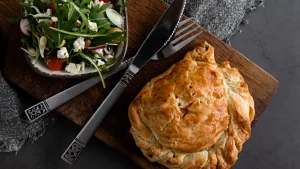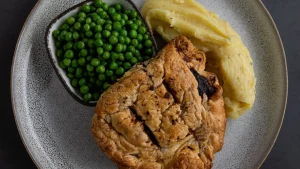For many people from the UK and Ireland, adapting to life in Germany means finding equivalents or substitutes for a surprisingly wide arrange of ingredients which we grow up taking for granted, but just don’t exist elsewhere. Malt vinegar, for example. Beef suet is another product which very much belongs to this category. It’s a somewhat unassuming but essential ingredient in traditional British cooking, often used to enhance the flavors and textures of various dishes. And the best-known brand is, of course, Atora.
What is Beef Suet?
Beef suet is a type of fat that comes from the visceral, or internal, fat deposits of a cow. Unlike the marbled fat you might find within a steak, beef suet is obtained from the areas surrounding the kidneys and other internal organs. This fat is typically firm and white, with a distinctive granular texture. It’s worth noting that suet isn’t exclusive to beef; it can also be sourced from other animals like sheep and pigs, but beef suet is among the most commonly used varieties, and Atora is made from 100% shredded beef suet.
What is beef suet used for?
Beef suet is a versatile ingredient with a range of culinary applications. Its primary use is in baking and traditional British recipes, where it’s valued for the rich, savory flavor it imparts to dishes. Here are a few common uses:
Pastry Making: In British cuisine, suet is an essential component of suet pastry, a rich, crumbly dough used for savory and sweet pies, dumplings, and puddings. When heated, it creates air pockets within the dough, resulting in that uniquely flaky, tender texture that’s hard to reproduce without that all-important suet.
Puddings: Suet is a key ingredient in traditional British puddings like Christmas pudding and steak and kidney pudding. Its high melting point allows it to retain its structure during steaming, creating a moist, tender interior.
Stuffing: Some people would argue that stuffing is even tastier than the bird or joint it comes in! Certainly it’s a much-loved component of a traditional roast dinner. Some stuffing recipes call for suet to enhance flavor and moistness. It can be used in both meat and vegetarian stuffing preparations.
Bird Feeding: British people love the feathered visitors to their gardens, and many try to help them get through the winter months by putting food out for them. Suet’s a wonderfully energy-dense, nutritious treat for birds, especially with the addition of seeds, grains or dried fruit to create suet cakes.
Meat Dishes: In some savoury dishes, suet can be used to add richness and depth of flavour. For instance, it’s a traditional ingredient in dishes like steak and kidney pie, where it lends a luscious quality to the gravy.
So if you’ve been missing that magic ingredient which makes your pies irresistible, look no further – as always, Dalriata’s got you covered! Atora’s available now.


















